HPLC-Based Detection of Two Distinct Red Tide Causative Species (Mesodinium rubrum and Margalefidinium polykrikoides) in the South Sea of Korea
Abstract
1. Introduction
2. Materials and Methods
2.1. Study Site and Water Sampling
2.2. HPLC Pigment and CHEMTAX Analysis
- Area = area of the peak in the sample [area];
- Rf = standard response factor [ngL−1 area−1];
- Ve = AIS/(peak area of IS added to sample) × (volume of IS added to sample) [L];
- Vs = volume of filtered water sample [L];
- AIS = peak area of IS when 1 mL IS is mixed with 300 μL of H2O;
- IS = internal standard.
2.3. Phytoplankton Identification and Enumeration
2.4. Suspended Particulate Matter
3. Results
3.1. Environmental Conditions
3.2. Plankton Assemblage by Microscopic Observation
3.3. HPLC Pigment and CHEMTAX Results
3.4. Relationship between Microscopic Observation and CHEMTAX Estimates
4. Discussion
5. Summary and Conclusions
Author Contributions
Funding
Data Availability Statement
Conflicts of Interest
References
- Jeong, H.J.; Kang, C.K. Understanding and managing red tides in Korea Preface. Harmful Algae 2013, 30, S1–S2. [Google Scholar] [CrossRef]
- National Fisheries Research and Development Institute (NFRDI). Harmful Algal Blooms in Korean Nearshore Waters in 2013. Research Report of National Fisheries Research and Development Institute; National Fisheries Research and Development Institute: Incheon, Republic of Korea, 2014; p. 173. (In Korean)
- Lim, W.; Go, W.J.; Kim, K.-Y.; Park, J.-W. Variation in harmful algal blooms in Korean coastal waters since 1970. J. Korean Soc. Mar. Environ. Saf. 2020, 26, 523–530. [Google Scholar] [CrossRef]
- Lee, C.K.; Park, T.G.; Park, Y.T.; Lim, W.A. Monitoring and trends in harmful algal blooms and red tides in Korean coastal waters, with emphasis on Cochlodinium polykrikoides. Harmful Algae 2013, 30, S3–S14. [Google Scholar] [CrossRef]
- Kim, S.M.; Shin, J.; Baek, S.; Ryu, J.-H. U-Net convolutional neural network model for deep red tide learning using GOCI. J. Coast. Res. 2019, 90, 302–309. [Google Scholar] [CrossRef]
- National Institute of Fisheries Science (NIFS). Past Red Tide Occurrence Data; NIFS: Busan, Republic of Korea, 2020; Available online: http://www.nifs.go.kr/red/news/news_2020.jsp (accessed on 22 August 2023).
- Park, J.; Jin, H.; Du, Y.; Young, E. Mixotrophic dinoflagellate red tides in Korean waters: Distribution and ecophysiology. Harmful Algae 2013, 30, 28–40. [Google Scholar] [CrossRef]
- Lee, C.K.; Kim, H.C.; Lee, S.-G.; Jung, C.S.; Kim, H.G.; Lim, W.A. Abundance of Harmful Algae, Cochlodinium polykrikoides, Â Gyrodinium impudicum and Gymnodinium catenatum in the Coastal Area of South Sea of Korea and Their Effects of Temperature, Salinity, Irradiance and Nutrient on the Growth in Culture. J. Korean Fish. Soc. Pusan 2001, 34, 536–544. [Google Scholar]
- Kang, Y.S.; Kim, H.G.; Lim, W.E.; Lee, C.K. An unusual coastal environment and Cochlodinium polykrikoides blooms in 1995 in the South Sea of Korea. J. Korean Soc. Oceanogr. 2002, 37, 212–223. [Google Scholar]
- Sarma, Y.V.B.; Al-Hashmi, K.; Smith, S.L. Sea surface warming and its implications for harmful algal blooms off Oman. Int. J. Mar. Sci. 2013, 3, 65–71. [Google Scholar] [CrossRef]
- Harun, S.N.; Mohammad-Noor, N.; Ahmad, Z.; Chu, K.B.; Saad, S.; Mohamad Hidayat, N.S.; MuKai, Y. First report of Cochlodinium polykrikoides (Dinophyceae), a harmful algal bloom (HAB) species in the coastal waters of peninsular Malaysia. Malays J. Sci. 2015, 34, 87–92. [Google Scholar] [CrossRef]
- NFRDI. Monitoring, management and mitigation of red tide. In Annual Report of NFRDI on Red Tide of Korea; NFRDI: Busan, Republic of Korea, 2012. (In Korean) [Google Scholar]
- Park, T.G.; Lim, W.A.; Park, Y.T.; Lee, C.K.; Jeong, H.J. Economic impact, management and mitigation of red tides in Korea. Harmful Algae 2013, 30, 131–143. [Google Scholar] [CrossRef]
- Kang, H.E.; Yoon, T.H.; Park, J.W.; Lim, W.A.; Kang, C.K.; Kim, H.W. A Study on the Possibility of Early Warning for Cochlodinium polykrikoides Blooms, Using Molecular Methods. Water 2022, 14, 3115. [Google Scholar] [CrossRef]
- Lee, M.O.; Choi, J.H.; Park, I.H. Outbreak conditions for Cochlodinium polykrikoides blooms in the southern coastal waters of Korea. Mar. Environ. Res. 2010, 70, 227–238. [Google Scholar] [CrossRef] [PubMed]
- Yih, W.; Kim, H.S.; Myung, G.; Park, J.W.; Yoo, Y.D.; Jeong, H.J. The red-tide ciliate Mesodinium rubrum in Korean coastal waters. Harmful Algae 2013, 30, 53–61. [Google Scholar] [CrossRef]
- Kang, J.J.; Lee, J.H.; Kim, H.C.; Lee, W.C.; Lee, D.; Jo, N.; Min, J.-O.; Lee, S.H. Monthly Variations of Phytoplankton Community in Geoje-Hansan Bay of the Southern Part of Korea Based on HPLC Pigment Analysis. J. Coast. Res. 2018, 85, 356–360. [Google Scholar] [CrossRef]
- Kim, Y.; Youn, S.H.; Oh, H.J.; Kang, J.J.; Lee, J.H.; Lee, D.; Kim, K.; Jang, H.K.; Lee, J.; Lee, S.H. Spatiotemporal variation in phytoplankton community driven by environmental factors in the northern East China Sea. Water 2020, 12, 2695. [Google Scholar] [CrossRef]
- Noh, J.H.; Kim, W.; Son, S.H.; Ahn, J.-H.; Park, Y.-J. Remote quantification of Cochlodinium polykrikoides blooms occurring in the East Sea using geostationary ocean color imager (GOCI). Harmful Algae 2018, 73, 129–137. [Google Scholar] [CrossRef] [PubMed]
- Kang, H.E.; Yoon, T.H.; Yoon, S.; Kim, H.J.; Park, H.; Kang, C.K.; Kim, H.W. Genomic analysis of red-tide water bloomed with Heterosigma akashiwo in Geoje. PeerJ 2018, 6, e4854. [Google Scholar] [CrossRef]
- Wong, C.K.; Wong, C.K. HPLC pigment analysis of marine phytoplankton during a red tide occurrence in Tolo Harbour, Hong Kong. Chemosphere 2003, 52, 1633–1640. [Google Scholar] [CrossRef]
- Sun, Y.; Youn, S.H.; Oh, H.J.; Joo, H.T.; Kim, Y.; Kang, J.J.; Lee, S.H. Spatial and temporal distribution of phytoplankton community in relation to environmental factors in the southern coastal waters of Korea. Front. Mar. Sci. 2022, 9, 950234. [Google Scholar] [CrossRef]
- Wright, S.W.; Jeffrey, S.W.; Mantoura, R.F.C.; Llewellyn, C.A.; Bjornland, D.; Repeta, D.; Welschmeyer, N. Improved HPLC method for the analysis of chlorophylls and carotenoids from marine phytoplankton. Mar. Ecol. Prog. Ser. 1991, 77, 183–196. [Google Scholar] [CrossRef]
- Jeffrey, S.W.; Mantoura, R.F.C.; Wright, S.W. (Eds.) Phytoplankton Pigments in Oceanography: Guidelines to Modern Methods; UNESCO Publishing: Paris, France, 1997. [Google Scholar]
- Mantoura, R.F.C.; Barlow, R.G.; Head, E.J.H. Simple Isocratic HPLC Methods for Chlorophylls and Their Degradation Products; NASA: Washington, DC, USA, 1997.
- Zapata, M.; Rodriguez, F.; Garrido, J.L. Separation of chlorophylls and carotenoids from marine phytoplankton: A new HPLC method using a reversed phase C-8 column and pyridine-containing mobile phases. Mar. Ecol. Prog. Ser. 2000, 195, 29–45. [Google Scholar] [CrossRef]
- Lee, Y.W.; Park, M.O.; Im, Y.S.; Kim, S.S.; Kang, C.K. Application of photosynthetic pigment analysis using a HPLC and CHEMTAX program to studies of phytoplankton community composition. Sea 2011, 16, 117–124. [Google Scholar] [CrossRef]
- Mackey, M.D.; Mackey, D.J.; Higgins, H.W.; Wright, S.W. CHEMTAX—A program for estimating class abundances from chemical markers: Application to HPLC measurements of phytoplankton. Mar. Ecol. Prog. Ser. 1996, 144, 265–283. [Google Scholar] [CrossRef]
- Wright, S.W.; Thomas, D.P.; Marchant, H.J.; Higgins, H.W.; Mackey, M.D.; Mackey, D.J. Analysis of phytoplankton of the Australian sector of the Southern Ocean: Comparisons of microscopy and size frequency data with interpretations of pigment HPLC data using the ‘CHEMTAX’ matrix factorization program. Mar. Ecol. Prog. Ser. 1996, 144, 285–298. [Google Scholar] [CrossRef]
- Wright, S.W.; van den Enden, R.L. Phytoplankton community structure and stocks in the East Antarctic marginal ice zone (BROKE survey, January–March 1996) determined by CHEMTAX analysis of HPLC pigment signatures. Deep. Sea Res. II 2020, 47, 2363–2400. [Google Scholar] [CrossRef]
- Utermöhl, H. Zur Vervollkommnung der quantitativen Phytoplankton Methodik. Int. Ver. Theor. Angew. Limnol. Mitt. 1958, 9, 1–38. [Google Scholar] [CrossRef]
- Neukermans, G.; Ruddick, K.; Loisel, H.; Roose, P. Optimization and quality control of suspended particulate matter concentration measurement using turbidity measurements. Limnol. Oceanogr. Methods 2012, 10, 1011–1023. [Google Scholar] [CrossRef]
- Kim, Y.; Byun, Y.; Kim, Y.; Eo, Y. Detection of Cochlodinium polykrikoides red tide based on two-stage filtering using modis data. Desalination 2009, 249, 1171–1179. [Google Scholar] [CrossRef]
- Peltomaa, E.; Johnson, M.D. Mesodinium rubrum exhibits genus-level but not species-level cryptophyte prey selection. Aquat. Microb. Ecol. 2017, 78, 147–159. [Google Scholar] [CrossRef]
- Nishitani, G.; Yamaguchi, M. Seasonal succession of ciliate Mesodinium spp. with red, green, or mixed plastids and their association with cryptophyte prey. Sci. Rep. 2018, 8, 17189. [Google Scholar] [CrossRef]
- Kim, W.; Han, T.H.; Jung, S.W.; Kang, D. Analysis on the Optical Absorption Property of Sea Waters Dominated by Alexandrium affine in Coastal Waters off Tongyeong, 2017. J. Korean Soc. Surv. Geod. Photogramm 2019, 37, 563–570. [Google Scholar]
- Kwon, H.K.; Kim, G.; Lim, W.A.; Park, J.W. In-situ production of humic-like fluorescent dissolved organic matter during Cochlodinium polykrikoides blooms. Estuar. Coast. Shelf Sci. 2018, 203, 119–126. [Google Scholar] [CrossRef]
- Herfort, L.; Peterson, T.D.; McCue, L.A.; Crump, B.C.; Prahl, F.G.; Baptista, A.M.; Campbell, V.; Warnick, R.; Selby, M.; Roegner, G.C.; et al. Myrionecta rubra population genetic diversity and its cryptophyte chloroplast specificity in recurrent red tides in the Columbia River estuary. Aquat. Microb. Ecol. 2011, 62, 85–97. [Google Scholar] [CrossRef][Green Version]
- Johnson, M.D.; Beaudoin, D.J.; Laza-Martínez, A.; Dyhrman, S.T.; Fensin, E.; Lin, S.; Merculief, A.; Nagai, S.; Pompeu, M.; Setälä, O. The genetic diversity of Mesodinium and associated Cryptophytes. Front. Microbiol. 2016, 7, 2017. [Google Scholar] [CrossRef] [PubMed]
- Kim, H.S.; Kim, Y.G.; Yang, J.S.; Yih, W. Comparative population dynamics of photosynthetic ciliate Mesodinium rubrum (=Myrionecta rubra) in Gomso Bay and the Geum River Estuary, Korea. Sea J. Korean Soc. Oceanogr. 2004, 9, 164–172, (In Korean with English Abstract). [Google Scholar]
- Yoo, Y.D.; Seong, K.A.; Myung, G.; Kim, H.S.; Jeong, H.J.; Palenik, B.; Yih, W. Ingestion of the unicellular cyanobacterium Synechococcus by the mixotrophic red tide ciliate Mesodinium rubrum. Algae 2015, 30, 281–290. [Google Scholar] [CrossRef]
- Yih, W.; Kim, H.S.; Jeong, H.A.; Myung, G.; Kim, Y.G. Ingestion of cryptophyte cells by the marine photosynthetic ciliate Mesodinium rubrum. Aquat. Microb. Ecol. 2004, 36, 165–170. [Google Scholar] [CrossRef]
- Myung, G.; Yih, W.; Kim, H.S.; Park, J.S.; Cho, B.C. Ingestion of bacterial cells by the marine photosynthetic ciliate Myrionecta rubra. Aquat. Microb. Ecol. 2006, 44, 175–180. [Google Scholar] [CrossRef]
- Johnson, M.D.; Tengs, T.; Oldach, D.; Stoecker, D.K. Sequestration, performance, and functional control of cryptophyte plastids in the ciliate Myrionecta rubra (Ciliophora). J. Phycol. 2006, 42, 1235–1246. [Google Scholar] [CrossRef]
- Park, J.S.; Myung, G.; Kim, H.S.; Cho, B.C.; Yih, W. Growth responses of the marine photosynthetic ciliate Myrionecta rubra to different cryptomonad strains. Aquat. Microb. Ecol. 2007, 48, 83–90. [Google Scholar] [CrossRef]
- Nishitani, G.; Nagai, S.; Baba, K.; Kiyokawa, S.; Kosaka, Y.; Miyamura, K.; Nishikawa, T.; Sakurada, K.; Shinada, A.; Kamiyama, T. High-level congruence of Myrionecta rubra prey and Dinophysis species plastid identities as revealed by genetic analyses of isolates from Japanese coastal waters. Appl. Environ. Microbiol. 2010, 76, 2791–2798. [Google Scholar] [CrossRef]
- Myung, G.; Kim, H.S.; Park, J.W.; Park, J.S.; Yih, W. Sequestered plastids in Mesodinium rubrum are functionally active up to 80 days of phototrophic growth without cryptomonad prey. Harmful Algae 2013, 27, 82–87. [Google Scholar] [CrossRef]
- Myung, G.O.; Kim, H.S.; Jang, K.G.; Park, J.W.; Yih, W.H. Importance of the mixotrophic ciliate Myrionecta rubra in marine ecosystems. Sea Korean Soc. Oceanogr. 2007, 12, 178–185, (In Korean with English Abstract). [Google Scholar]
- Kim, H.S. Population Dynamics and Environmental Conditions for the Continuous Growth of the Phototrophic Ciliate, Mesodinium rubrum in Korean West Coast. Ph.D. Thesis, Graduate School, Kunsan National Crob. Ecol., Gunsan, Republic of Korea, 2002. (In Korean with English Abstract). [Google Scholar]
- Herfort, L.; Peterson, T.D.; Prahl, F.G.; McCue, L.A.; Needoba, J.A.; Crump, B.C.; Roegner, G.C.; Campbell, V.; Zuber, P. Red Waters of Myrionecta rubra are Biogeochemical Hotspots for the Columbia River Estuary with Impacts on Primary/Secondary Productions and Nutrient Cycles. Estuaries Coasts 2012, 35, 878–891. [Google Scholar] [CrossRef]
- Johnson, M.D.; Stoecker, D.K.; Marshall, H.G. Seasonal dynamics of Mesodinium rubrum in Chesapeake Bay. J. Plankton Res. 2013, 35, 877–893. [Google Scholar] [CrossRef]
- Lee, E.; Son, M.; Kim, J.B.; Lee, W.C.; Jeon, G.E.; Lee, S.H. A study of variation characteristics of the phytoplankton community by UPLC located in the Jinju Bay, Korea. Korean J. Environ. Biol. 2018, 36, 62–72, (In Korean with English Abstract). [Google Scholar] [CrossRef]
- Kang, J.-J.; Min, J.-O.; Kim, Y.; Lee, C.-H.; Yoo, H.; Jang, H.-K.; Kim, M.-J.; Oh, H.-J.; Lee, S.-H. Vertical Distribution of Phytoplankton Community and Pigment Production in the Yellow Sea and the East China Sea during the Late Summer Season. Water 2021, 13, 3321. [Google Scholar] [CrossRef]
- Noh, I.H.; Yoon, Y.H.; Park, J.S.; Kang, I.S.; An, Y.K.; Kim, S.H. Seasonal fluctuations of marine environment and phytoplankton community in the southern part of Yeosu, southern sea of Korea. J. Korean Soc. Mar. Environ. Energy 2010, 13, 151–164. [Google Scholar]
- Kudela, R.M.; Gobler, C.J. Harmful dinoflagellate blooms caused by Cochlodinium sp.: Global expansion and ecological strategies facilitating bloom formation. Harmful Algae 2012, 14, 71–86. [Google Scholar] [CrossRef]
- Lim, W.A.; Jung, C.S.; Lee, C.K.; Cho, Y.C.; Lee, S.G.; Kim, H.G.; Chung, I.K. The outbreak, maintenance and decline of the red tide dominated by Cochlodinium polykrikoides in the coastal waters off southern Korea from August to October, 2000. Korean Soc. Oceanogr. 2002, 7, 68–77. [Google Scholar]
- Lim, W.; Lee, Y.S.; Park, J.G. Characteristics of Cochlodinium polykrikoides bloom in southeast coastal waters of Korea, 2008. The Sea. Korean Soc. Oceanogr. 2009, 14, 155–162, (In Korean with English Abstract). [Google Scholar]
- Kim, H.C.; Lee, C.K.; Lee, S.G.; Kim, H.G.; Park, C.K. Physico-chemical factors on the growth of Cochlodinium polykrikoides and nutrient utilization. J. Korean Fish. Soc. 2001, 34, 445–456, (In Korean with English Abstract). [Google Scholar]
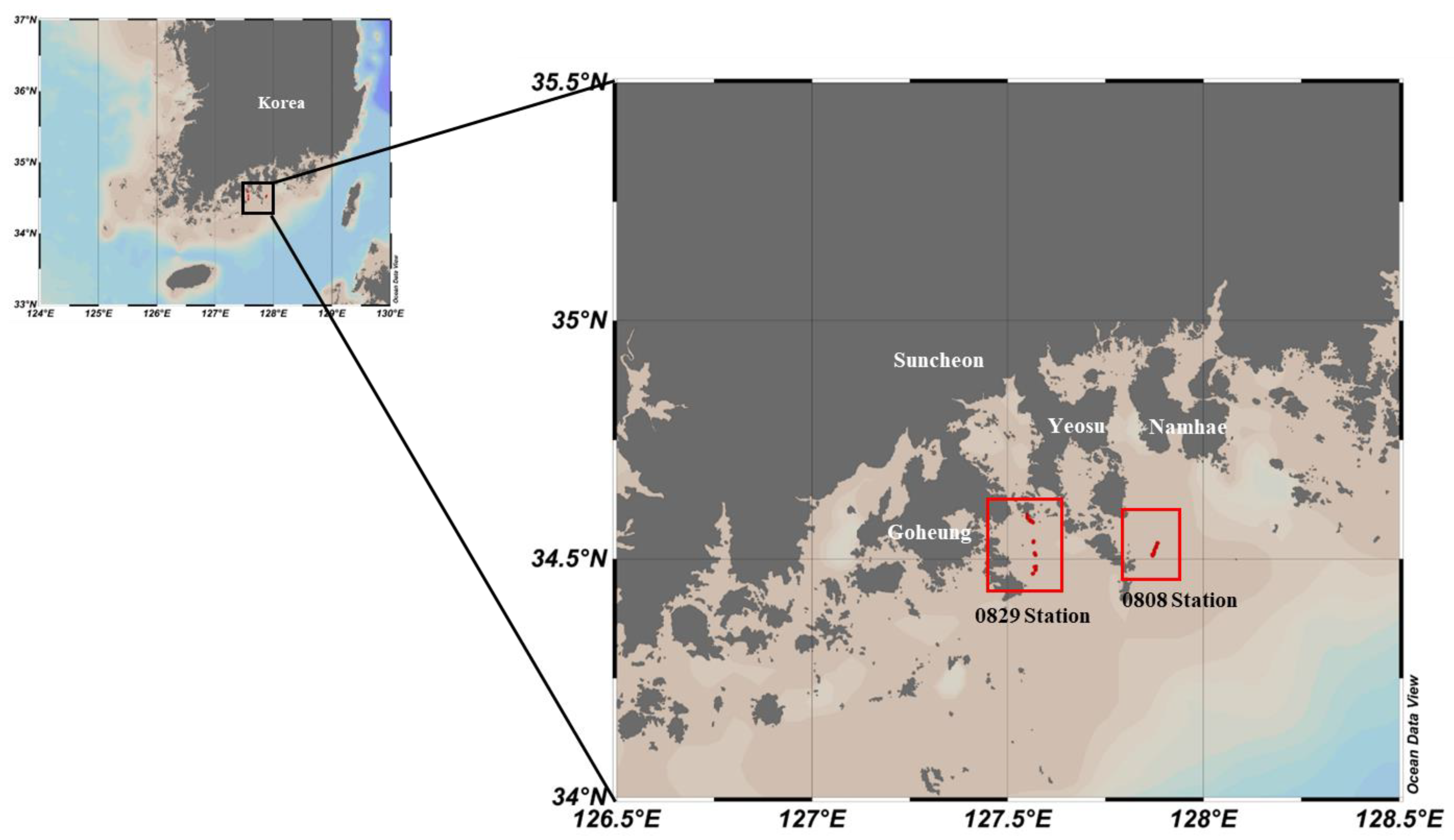
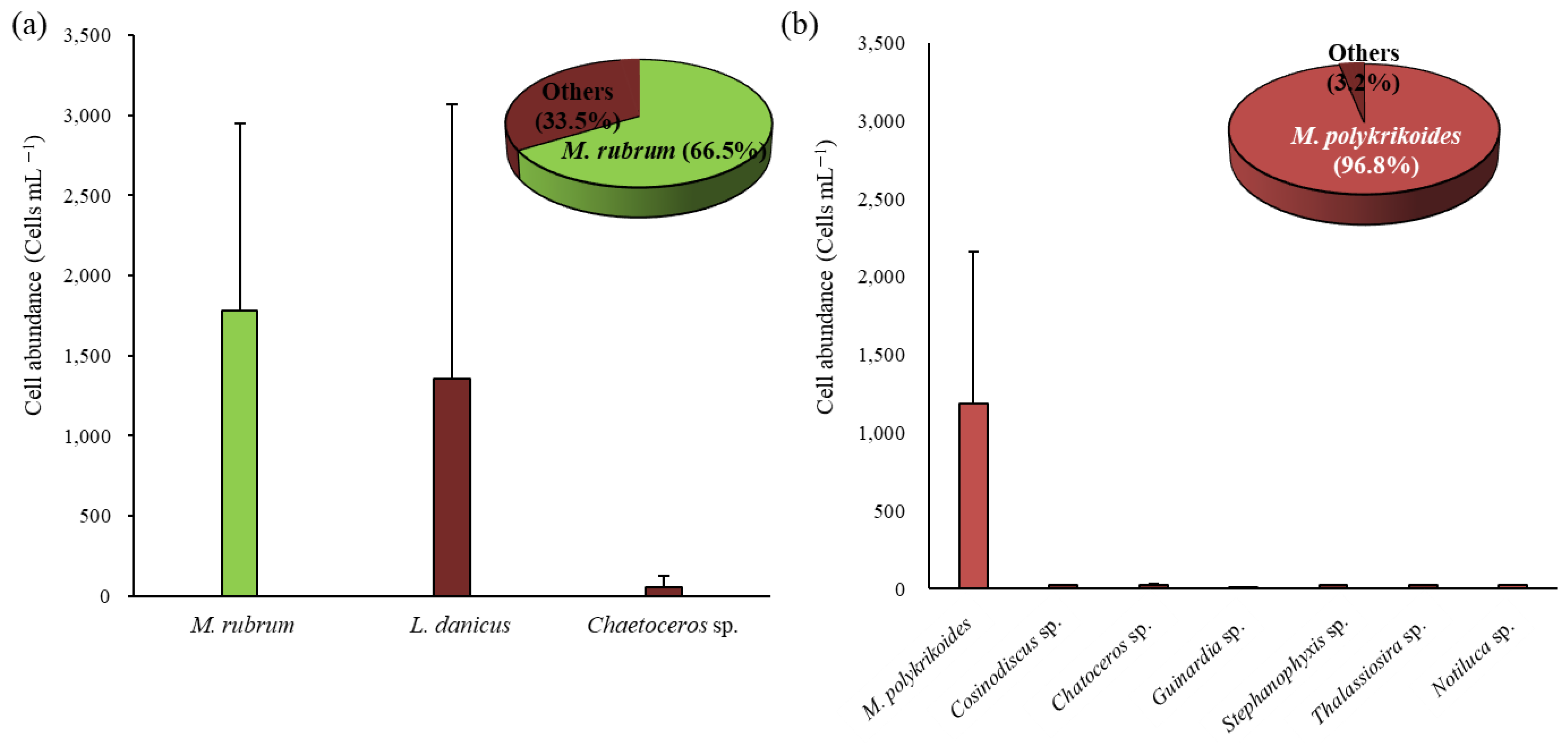

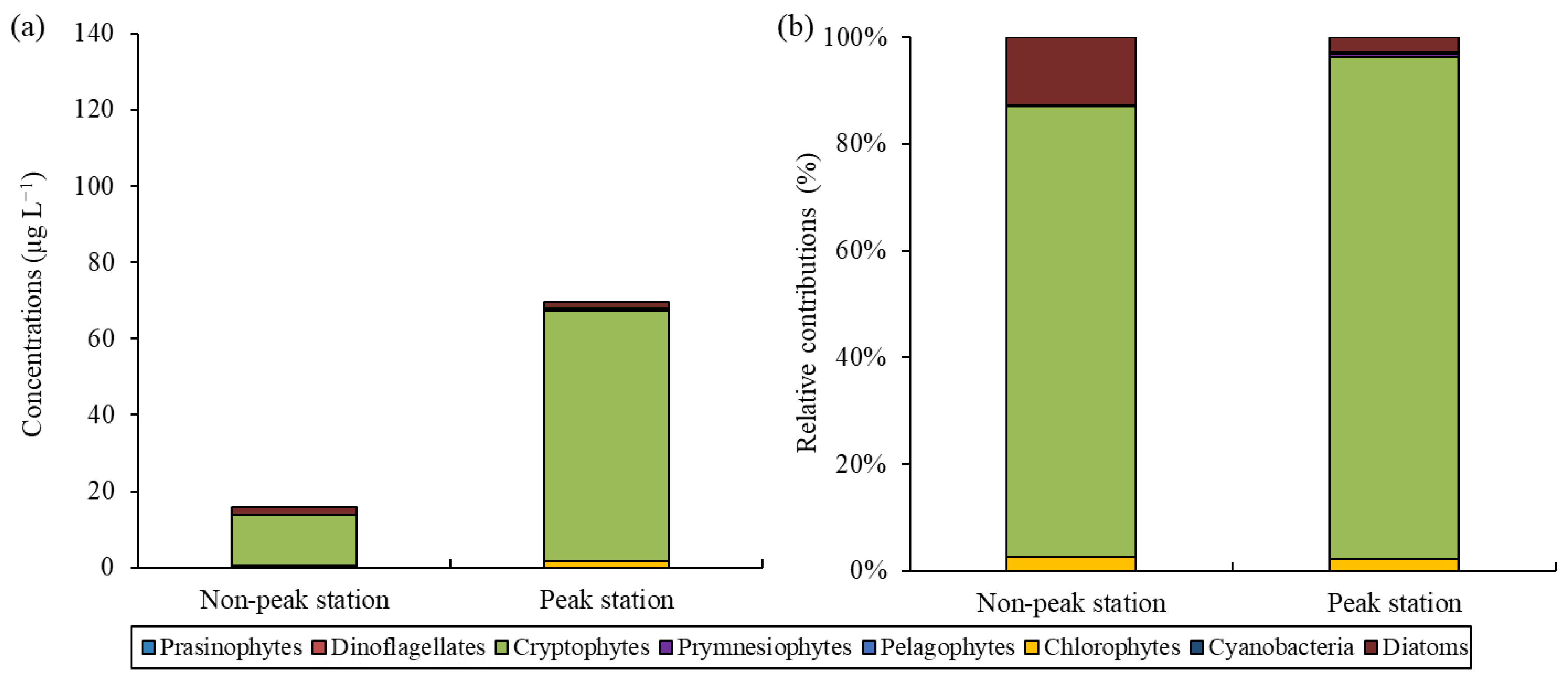
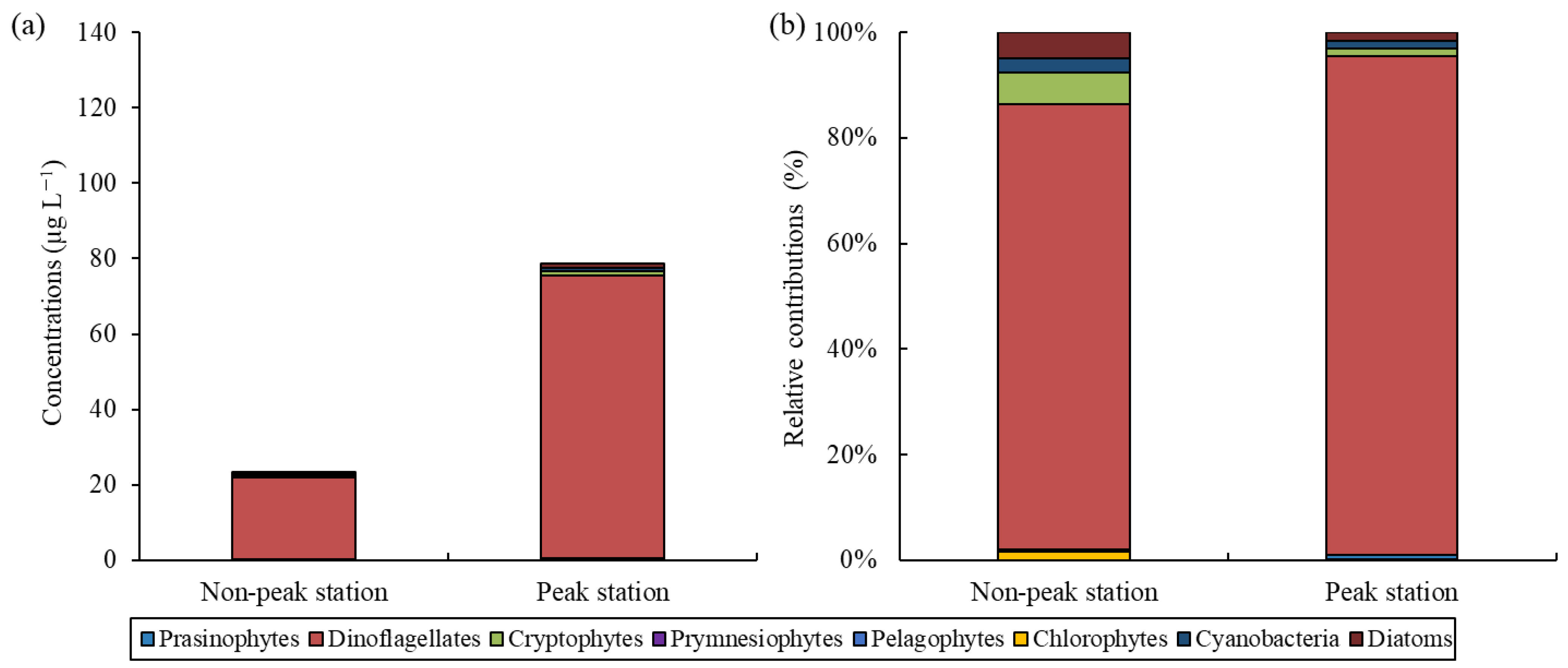
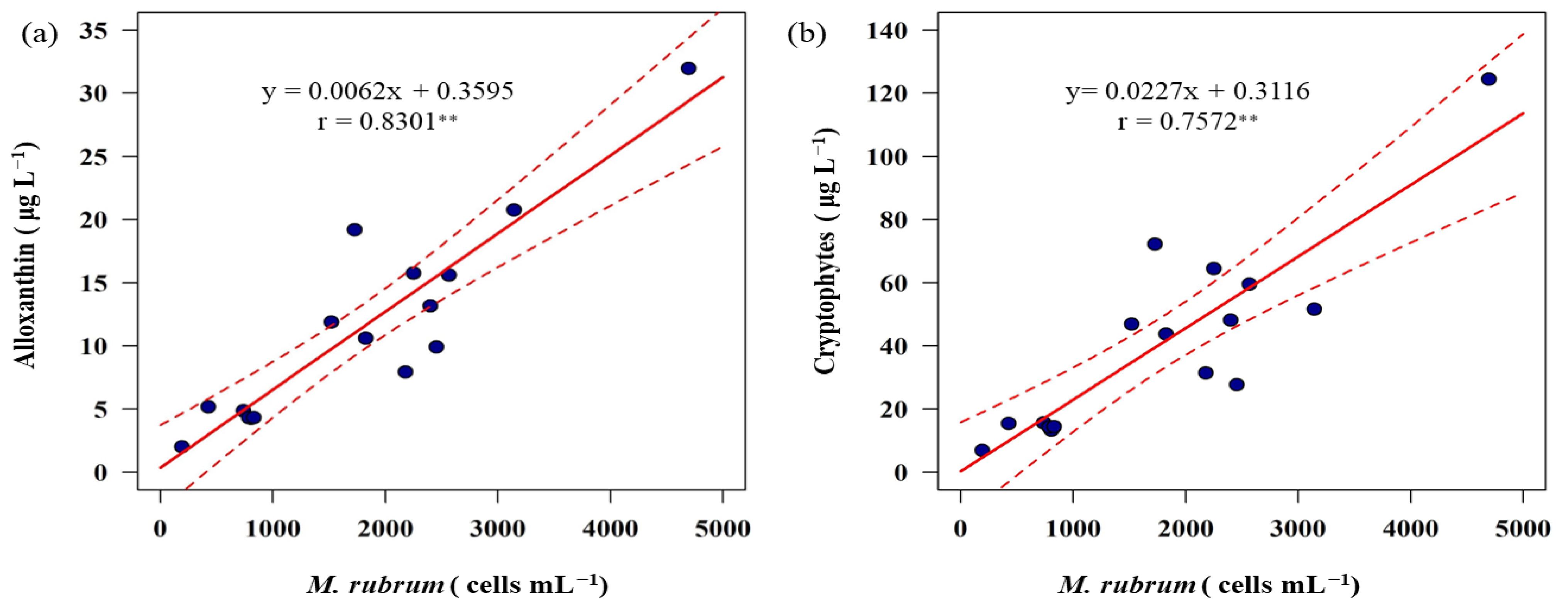
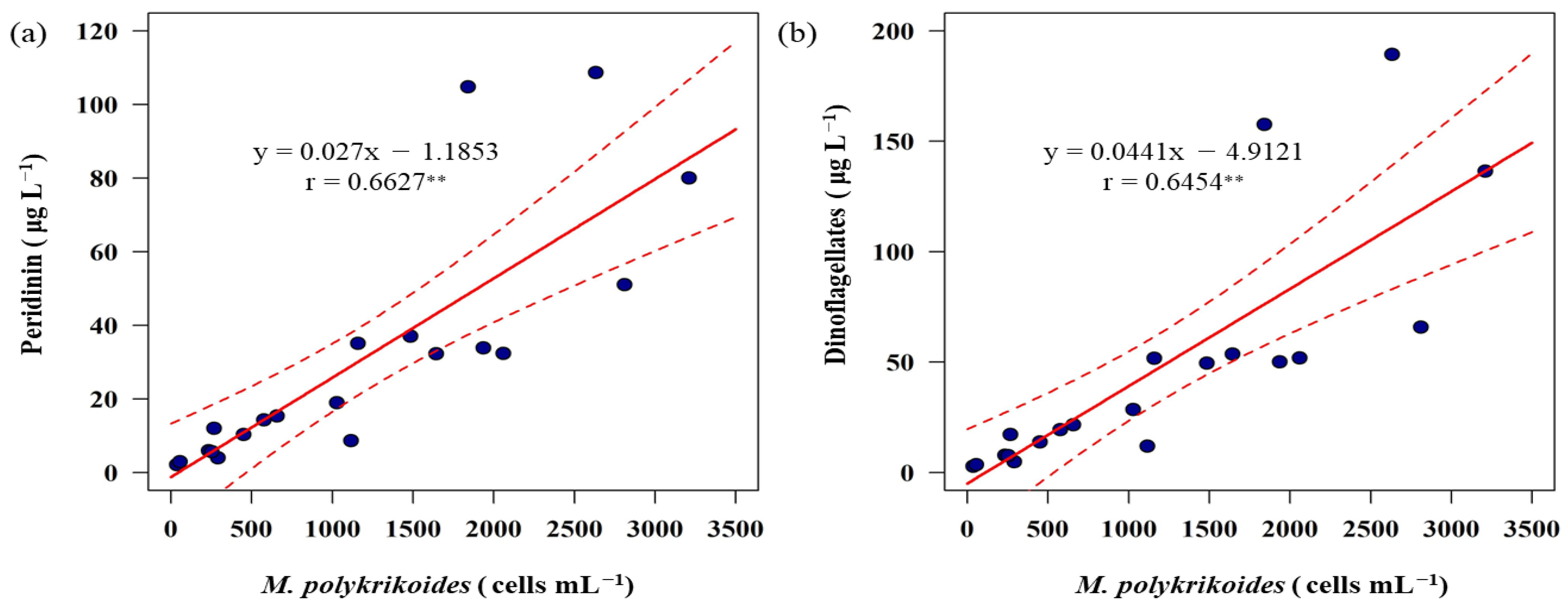
| Day | Station | Latitude | Longitude | Depth | Temperature (°C) | SPM (g/m3) | chl-a (µg/L) | Dominant Species (%) |
|---|---|---|---|---|---|---|---|---|
| 8 August 2022 | A1-1 | 34.5335 | 127.8825 | 25.5 | 26.8 | 8.416 | 15.413 | L. danicus (79.6) |
| A1-2 | 34.5335 | 127.8835 | 25.5 | 26.8 | 4.078 | 9.114 | L. danicus (92.8) | |
| A2-1 | 34.5274 | 127.8802 | - | - | 19.522 | 29.925 | M. rubrum (99.2) | |
| A3-1 | 34.5241 | 127.8789 | 26.8 | 27.0 | 10.016 | 17.944 | M. rubrum (96.6) | |
| A3-2 | 34.5241 | 127.8782 | 26.8 | 27.0 | 22.770 | 54.802 | M. rubrum (97.2) | |
| A4-1 | 34.5181 | 127.8748 | 26.5 | 27.0 | 6.716 | 17.302 | L. danicus (73.0) | |
| A4-2 | 34.5140 | 127.8742 | 26.5 | 27.0 | 35.772 | 35.189 | L. danicus (49.7) | |
| A4-3 | 34.5141 | 127.8743 | 28.0 | 27.0 | 33.588 | 52.021 | L. danicus (58.5) | |
| A5-1 | 34.5125 | 127.8734 | 28.5 | 27.0 | 36.012 | 77.447 | M. rubrum (82.9) | |
| A5-2 | 34.5125 | 127.8737 | 28.5 | 27.0 | 26.264 | 130.540 | M. rubrum (57.8) | |
| A6-1 | 34.5107 | 127.8729 | 29.0 | 27.2 | 30.864 | 70.024 | M. rubrum (89.1) | |
| A6-2 | 34.5101 | 127.8724 | 29.0 | 27.2 | 23.864 | 47.033 | M. rubrum (91.6) | |
| A6-3 | 34.5094 | 127.8696 | 29.0 | 27.2 | 10.240 | 17.845 | M. rubrum (45.8) | |
| A6-4 | 34.5092 | 127.8695 | 29.0 | 27.2 | 8.174 | 16.672 | M. rubrum (75.6) | |
| A7-1 | 34.5078 | 127.8705 | 29.0 | 27.0 | 22.640 | 63.398 | M. rubrum (99.0) | |
| A7-2 | 34.5070 | 127.8701 | 30.0 | 27.0 | 23.916 | 50.484 | M. rubrum (94.9) | |
| 29 August 2022 | Y01 | 34.5934 | 127.5499 | 13.0 | 23.1 | 5.993 | 13.368 | M. polykrikoides (97.7) |
| Y02 | 34.5876 | 127.5499 | 16.0 | 23.5 | 9.133 | 4.200 | M. polykrikoides (100.0) | |
| Y03 | 34.5854 | 127.5509 | 16.0 | 23.5 | 6.100 | 23.836 | M. polykrikoides (100.0) | |
| Y04 | 34.5817 | 127.5572 | 16.0 | 23.6 | 6.567 | 30.934 | M. polykrikoides (100.0) | |
| Y05 | 34.5802 | 127.5581 | 16.0 | 23.7 | 6.067 | 15.601 | M. polykrikoides (98.7) | |
| Y06 | 34.5793 | 127.5583 | - | - | 7.100 | 4.755 | M. polykrikoides (70.0) | |
| Y07 | 34.5792 | 127.5607 | 15.0 | 23.7 | 15.533 | 57.675 | M. polykrikoides (99.8) | |
| Y08 | 34.5789 | 127.5630 | 14.5 | 23.8 | 4.167 | 6.760 | M. polykrikoides (96.2) | |
| Y09 | 34.5765 | 127.5648 | 14.2 | 23.8 | 8.467 | 55.109 | M. polykrikoides (99.8) | |
| Y10 | 34.5374 | 127.5662 | 12.3 | 24.1 | 6.733 | 52.662 | M. polykrikoides (100.0) | |
| Y11 | 34.5350 | 127.5658 | 12.2 | 24.1 | 11.400 | 19.618 | M. polykrikoides (95.7) | |
| Y12 | 34.5122 | 127.5688 | - | - | 11.467 | 144.047 | M. polykrikoides (99.9) | |
| Y13 | 34.5112 | 127.5692 | 12.0 | 24 | 9.067 | 53.884 | M. polykrikoides (96.7) | |
| Y14 | 34.5086 | 127.5713 | - | - | 14.267 | 197.619 | M. polykrikoides (99.5) | |
| Y15 | 34.4779 | 127.5716 | 12.0 | 24 | 14.733 | 161.699 | M. polykrikoides (100.0) | |
| Y16 | 34.4767 | 127.5711 | - | - | 7.333 | 50.790 | M. polykrikoides (100.0) | |
| Y17 | 34.4695 | 127.5652 | 11.7 | 24.1 | 6.200 | 67.441 | M. polykrikoides (99.7) | |
| Y18 | 34.4692 | 127.5642 | - | - | 4.867 | 19.871 | M. polykrikoides (98.3) | |
| Y19 | 34.4844 | 127.5725 | 11.8 | 24 | 22.467 | 8.795 | M. polykrikoides (95.1) | |
| Y20 | 34.4832 | 127.5683 | 11.8 | 23.8 | 25.933 | 8.764 | M. polykrikoides (88.7) |
Disclaimer/Publisher’s Note: The statements, opinions and data contained in all publications are solely those of the individual author(s) and contributor(s) and not of MDPI and/or the editor(s). MDPI and/or the editor(s) disclaim responsibility for any injury to people or property resulting from any ideas, methods, instructions or products referred to in the content. |
© 2023 by the authors. Licensee MDPI, Basel, Switzerland. This article is an open access article distributed under the terms and conditions of the Creative Commons Attribution (CC BY) license (https://creativecommons.org/licenses/by/4.0/).
Share and Cite
Kim, Y.; Park, S.; Jang, H.-K.; Choi, H.-Y.; Lee, J.-H.; Jung, S.-W.; Kim, W.; Koh, S.; Son, M.; Kwak, S.-N.; et al. HPLC-Based Detection of Two Distinct Red Tide Causative Species (Mesodinium rubrum and Margalefidinium polykrikoides) in the South Sea of Korea. Water 2023, 15, 3050. https://doi.org/10.3390/w15173050
Kim Y, Park S, Jang H-K, Choi H-Y, Lee J-H, Jung S-W, Kim W, Koh S, Son M, Kwak S-N, et al. HPLC-Based Detection of Two Distinct Red Tide Causative Species (Mesodinium rubrum and Margalefidinium polykrikoides) in the South Sea of Korea. Water. 2023; 15(17):3050. https://doi.org/10.3390/w15173050
Chicago/Turabian StyleKim, Yejin, Sanghoon Park, Hyo-Keun Jang, Ha-Young Choi, Jae-Hyung Lee, Seung-Won Jung, Wonkook Kim, Sooyoon Koh, Moonho Son, Seok-Nam Kwak, and et al. 2023. "HPLC-Based Detection of Two Distinct Red Tide Causative Species (Mesodinium rubrum and Margalefidinium polykrikoides) in the South Sea of Korea" Water 15, no. 17: 3050. https://doi.org/10.3390/w15173050
APA StyleKim, Y., Park, S., Jang, H.-K., Choi, H.-Y., Lee, J.-H., Jung, S.-W., Kim, W., Koh, S., Son, M., Kwak, S.-N., Ahn, S.-H., An, S., & Lee, S.-H. (2023). HPLC-Based Detection of Two Distinct Red Tide Causative Species (Mesodinium rubrum and Margalefidinium polykrikoides) in the South Sea of Korea. Water, 15(17), 3050. https://doi.org/10.3390/w15173050









